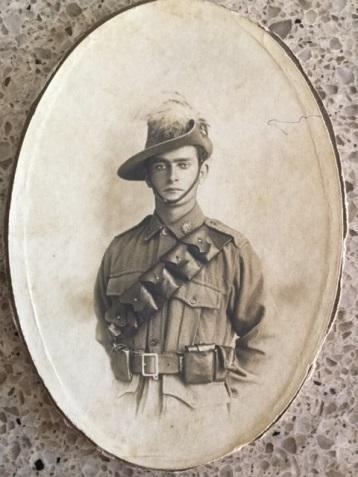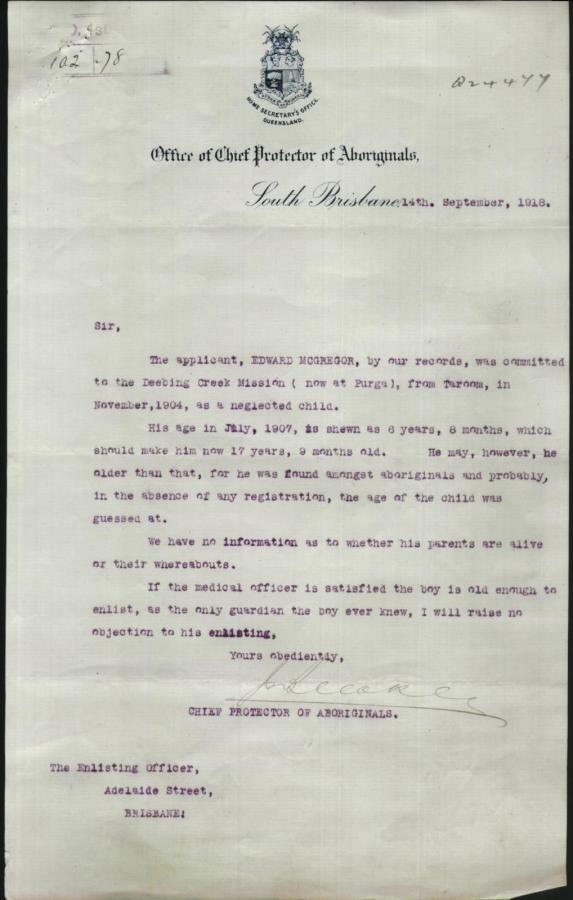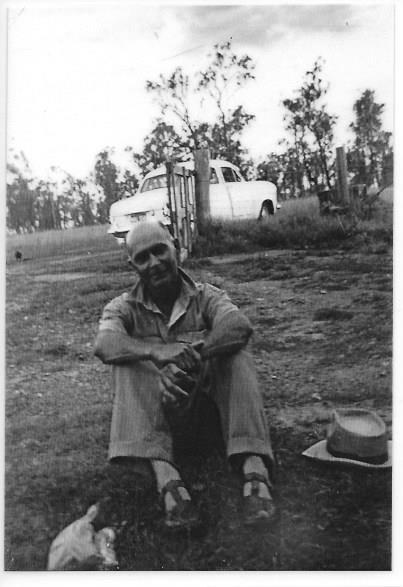'I’ve never had a birthday, so I’m not sure what date to write'

Edward McGregor
Edward McGregor (known as Eddie or Ned), enlisted to join the Australian Imperial Force in September 1918. After leaving Sydney in early November, the First World War ended with the signing of the Armistice, and the troopship Carpentaria on which he was travelling was recalled.
In 1942, McGregor again enlisted for service, serving in Queensland and New Guinea until being discharged in late January 1946.
Enlisting for service in two world wars is extraordinary enough; but what makes Edward McGregor’s story so compelling is the way that his experiences were influenced by the fact that his mother, Sarah Serrico, was an Aboriginal woman.
Edward was born around the turn of the century in Taroom, Queensland, which by then had already seen bloody evidence of the tradition of fighting for Country. In direct retaliation for the deaths of 12 Iman people, the Hornet Bank massacre of 27 October 1857 saw the death of 11 British colonists and an Aboriginal stablehand, leading to vicious reprisals and the indiscriminate shooting of Iman men, women and children; the Iman fought for their Country with such determination that they were almost entirely wiped out.
Edward was apprehended at Taroom on 11 January 1904 for “being a neglected child”. Described as a five-year-old “half caste aboriginal”, he was removed to Deebing Creek Industrial School, one of the earliest mission sites in Queensland.
Confusion over Edward’s age continued. In 1909 he went to work in Purga, a rural community on the outskirts of Ipswich, and Superintendent Morrison of the Myora Reserve Aboriginal Settlement guessed his age as 12 or 13. Morrison recounted, “He did not want to be called Serrico when he went to work so I gave him the surname of McGregor after the then Governor of Queensland.”
In September 1918, Edward volunteered to serve with the Australian Imperial Force, bringing with him a letter of permission from the Office of Chief Protector of Aborigines. When a doctor informed him that he had not filled in his date of birth, Edward replied, “I’ve never had a birthday, so I’m not sure what date to write.”
The doctor guessed that Edward had been born at the end of last century, and listed his age as 19. His next of kin was given as “Mr Blackley, Protector of Aboriginals, Brisbane, Queensland, Australia” and during Edward’s service, a portion of his pay would be sent to the Chief Protector of Aborigines.

Letter from the Office of the Chief Protector of Aboriginals, 14 September 1918
After several months training, Private McGregor embarked on the troopship Carpentaria in early November 1918, bound for service in England and France. However, those on board learnt of the end of the war as the ship reached Auckland harbour, and were returned to Australia.
Edward would again enlist in January 1942, going on to serve in the 1st Motor Transport Unit and 17th Labour Company, both at Goondiwini, before joining the 1st Ammunition Company at Wallangarra in New South Wales. He rejoined the 17th Labour Company in March 1943 and served around Brisbane area. In October 1944 he embarked on the troopship Katoomba for service in New Guinea during the Aitape-Wewak campaign. While there were men killed and wounded in battle during the campaign, they were far outnumbered by vast numbers of sickness casualties.
In March 1945, Edward was admitted to hospital suffering from tropical lichenoid dermatosis, and by May had been evacuated to Australia, eventually receiving treatment in Brisbane before being discharged on 29 January 1946.
He worked as a gardener at RAAF Base Amberley until retiring in 1964.
In 2000, Edward McGregor was presented with the Premier of Queensland’s Millennium Medal, as well as the 80th Anniversary of the Armistice Medal, which commemorated surviving First World War veterans.
He died on the 9th of September 2003, a member of the stolen generation who had enlisted in two world wars.

Edward McGregor

Edward McGregor